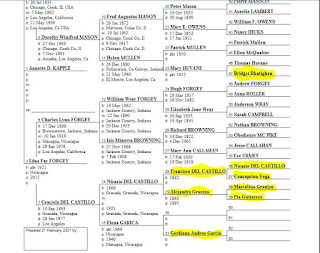I began this blog on March 1, 2011 so this is the 10th Anniversary of this blog. During the past 10 years I've shared the agony of waiting for DNA test results, and long waits for something in the mail. I've also shared the thrill of the ancestor chase and the satisfaction that came with breaking down brickwalls.
What have I accomplished and shared over this decade? First of all I've added some branches to my tree.
Below you can see just a few of the ancestors I've added since 2011 highlighted (couldn't get them all on a 6 generation chart):
With such a mixed heritage my genealogy research has led me to many different places through this decade.
Some accomplishments and sources I've blogged about in the past decade include:
- Photos of my Kappel/Kurta Great-Grandparents were shared with me in 2019, I had never seen photos of them. Had no idea what they looked like before 2019.
- Owens family brickwall came down in 2015 with a lawsuit and resulting deed documents surfacing.
- Granada Nicaragua Church and Civil Registration digitized records became available online at Familysearch allowing me to extend by Nicaraguan lines and collect family documents.
- Irish land records became available online such as the revision books for County Galway which extended my knowledge of my Irish families.
- Irish Civil Registration records online is another online source I've blogged about.
- Styria, Austria and Burgenland, Austria Church records have come online in the past few years helping me extend more family lines.
- Civil Registration records for Burgenland helped fill in blanks in my family history
- 1851Census Search Forms came online for Ireland allowing me to add mothers of my Irish great-great grandparents to my tree.
- In the past decade Findmypast Ireland has allowed me to extend my Irish families to include new dog family members using the dog license records. Court records have added new stories for my family history.
- Newspapers online have helped me confirm family lines and added new stories. A newspaper article provided me with the only photo I have of a great-uncle who was killed by a sniper in Germany at the end of WWII.
- Deed books coming online at Familysearch and other sites have helped add names to my family tree in the past decade. The James Trigg Campbell deed I located in Jackson County, Indiana may eventually break down my Campbell brickwall?
- We confirmed many lines through DNA testing. I started a Forgey family DNA project and a Kappel family project at FTDNA.
- IDing photos unmarked photos has also been a project I've been working on often using photo recognition websites.
- Naturalization certificate files with photos helped ID photos.
- I've blogged about information I've found on death certificates available online at sites such as Ancestry.com where old death certificates are available to view for free. Indiana death certificates are available online at Ancestry for instance. Other vital records now online have also been helpful.
- Virginia Memory Chancery records online has also been an invaluable resource which I've blogged about.
- I visited a courthouse in person for the first time in 2018 where I found documents not available online. I shared this experience in my blog.
- Luckily I was able to get to all of my ancestral related countries and states in the past few years before COVID shut travel down. I've shared those experiences in this blog.
Rootstech 2021
Aside from the DNA information a session on new features at Familysearch and another on tips for using the site were presented. I watched the sessions "Demo: Getting the Most from FamilySearch Search" and "What's New On FamilySearch".
Other sessions I found interesting:
- Tracing Ancestral Lines in the 1700s Using DNA
- Reconstructing Parent DNA
- Using DNA in a Client Research Project to Solve a Family Mystery (a case study that is interesting even if you don't take clients)
- DNA Triangulation: What, Why, and How
- Understanding Your DNA Ethnicity Results
- Ugo A. Perego: A Personal Genetic Journey
- Research in the Southern States
- Organize Your DNA Matches in a Diagram
- Research Strategies for Early Colonial Ancestors
















